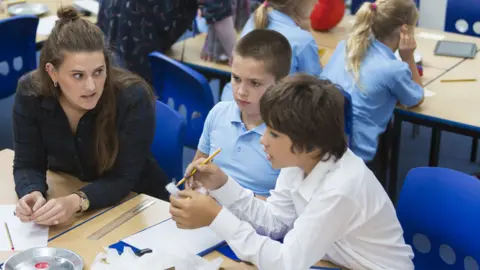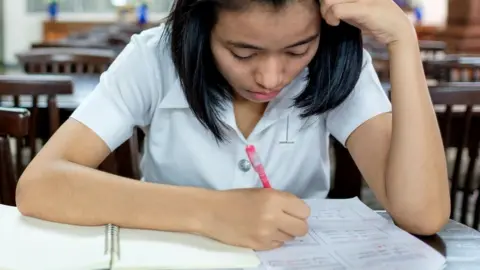Coronavirus: Heads say 1 June earliest realistic school opening
 Getty Images
Getty ImagesThe earliest "realistic" point at which schools in England could start re-opening would be 1 June, head teachers' leader Geoff Barton has said.
"We cannot see any realistic way that schools could be re-opened to more pupils before the second half of the summer term," said the ASCL leader.
And "planning would need to begin very soon" in order to meet a 1 June target.
Schools closed their doors to all except vulnerable children and those of key workers over a month ago.
 Reuters
ReutersAt the weekend, Education Secretary Gavin Williamson said no date was set for returning to school, quashing speculation about an imminent return.
The education secretary said if and when five thresholds in the fight against coronavirus were reached, a date could be set for schools to reopen:
- the NHS's ability to cope is fully protected
- the daily death rate is dropping
- infection rates are falling to manageable levels
- there are sufficient supplies of testing and protective equipment
- there is no risk of a "second peak" of infections
It's a safety-first approach, with school leaders backing the reliance on medical advice.
Once those requirements have been met, a date could be set for schools to re-open.
But it would not be immediate, with schools expecting a further "lead in" time, possibly of weeks, to prepare for a complicated, staged return that allows them to maintain social distancing.
Parents would also have to be persuaded it was safe.
With such a time frame, starting this half term becomes very unlikely. If opening after half term, it would mean somewhere in the seven weeks between 1 June and the term ending in mid-July.
But doubt has been cast on whether social distancing can really be feasible in schools.
Katharine Birbalsingh, head of Michaela Community School, in Brent, north London, criticised the "pretence" social distancing might work in schools, with narrow corridors, small classrooms and lots of interactions, particularly between younger children.
"Social distancing in schools is simply impossible," she said.
"We're considered to be the strictest school in Britain and even we would find it impossible."
And there are other questions around safety:
- Would children with family members vulnerable because of health conditions return to school?
- How many vulnerable staff would need to be shielded?
- What protective equipment might be needed for teachers?
Earlier this week, a petition from NHS nurse Iain Wilson warned against any early push to re-open schools.
"Do not make us the global guinea pigs," he said. "It is self-evidently unwise to force hundreds of people into small rooms in small buildings during a pandemic."
 Getty Images
Getty ImagesIf schools are to maintain social distancing, they could not run at full capacity, meaning a phased return, such as starting with a few year groups or pupils rotating between studying at home and school.
Mr Barton, general secretary of the Association of School and College Leaders, said it could mean staggering break times and putting a limit on class sizes.
Robert Halfon, who chairs the Education Select Committee, said primary schools should be the first back. This would help parents and stop disadvantaged youngsters falling behind at an early stage, the MP said.
But Mr Barton said the priority should be Years 10 and 12, who are part-way through GCSEs and A-levels, and Year 6, where children are about to move to secondary school.
And Jules White, head of Tanbridge House School, in West Sussex, asked what plans there would be for next summer's exams when so much study time has been lost.

Star academy trust chief executive Hamid Patel, meanwhile, said it should be up to each school to decide the order in which its pupils return.
There is also a possibility that some pupils will not go back at all this term - or at least for anything like a regular timetable.
"We want to be back as soon as it's safe," said National Education Union joint head Kevin Courtney.
"But there's a chance that there will be no full re-opening before the end of term.
"There's a responsibility to think about what that will mean for children's education."
But school leaders have repeatedly talked about the importance of getting pupils back before the school year finishes.
And in the meantime, other countries might provide evidence of how a return might work.
In France, primary-school pupils will start to go back, in classes of no more than 15, from 11 May.
And in the Netherlands, they will go back, on a part-time basis, on the same date, with secondary pupils returning from 1 June.
"What is crucial is that schools are able to re-open in a manner which inspires confidence among staff, pupils and parents - and that it is as safe as possible," said Mr Barton.
